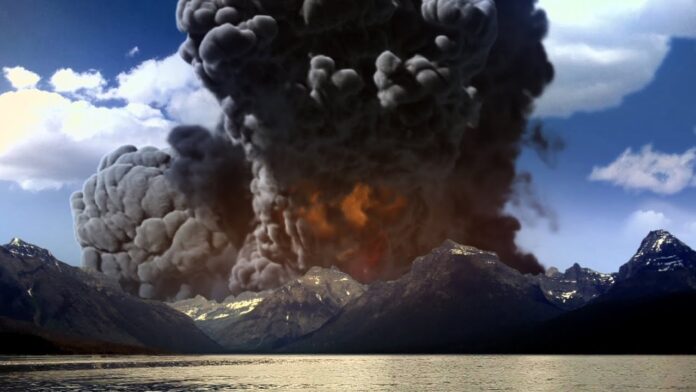Yellowstone Super volcano: Amid the serenity of geysers, bubbling hot springs, and scenic beauty, a colossal force lies dormant beneath Yellowstone National Park — a force that could, if awakened, reshape life not just in the United States, but across the globe.
This force is the Yellowstone Supervolcano, a massive geological structure and one of the most powerful natural phenomena on Earth. While it has remained inactive for hundreds of thousands of years, scientists are closely monitoring it, concerned about what its future holds.
🔍 What is the Yellowstone Supervolcano?
The Yellowstone Supervolcano, formally known as the Yellowstone Caldera, is located in the U.S. state of Wyoming, stretching into Montana and Idaho. Unlike typical volcanoes with cone-shaped peaks, this supervolcano is a giant underground magma chamber, spanning over 30 by 45 miles, lying beneath the earth’s surface.
It is classified as a supervolcano because its eruptions are at least 1,000 times more powerful than ordinary volcanic eruptions. The last major eruption occurred approximately 640,000 years ago, forming the massive caldera that defines Yellowstone’s modern geology.
💥 What Would Happen if It Erupts?
If the Yellowstone Supervolcano were to erupt in modern times, scientists predict a disaster of cataclysmic proportions. The eruption would likely release thousands of cubic kilometers of ash, lava, and volcanic gases, leading to massive destruction both regionally and globally.
🔸 Explosion Power:
- The force of the eruption could be equivalent to more than 1,000 nuclear bombs exploding simultaneously.
- A plume of volcanic ash could shoot 20–30 kilometers into the stratosphere, spreading across continents within days.
- The immediate area — including Wyoming, Montana, and Idaho — would be devastated, buried under feet of ash.
🔸 Regional Fallout:
- Local agriculture would be decimated. Ash would blanket farmlands, contaminate water supplies, and suffocate crops.
- Infrastructure would collapse. Roads, electrical grids, and communications systems in surrounding states could fail.
- Major cities like Denver, Salt Lake City, and even Chicago might feel the long-reaching effects, with air quality plummeting and economic activity grinding to a halt.
🌍 Global Consequences: A Volcanic Winter?
While the regional effects would be disastrous, it is the global implications that worry scientists the most.
When a supervolcano erupts, it ejects sulfur dioxide (SO₂) into the upper atmosphere, forming a layer of aerosol particles that block sunlight. This could result in a “volcanic winter,” a significant and prolonged drop in global temperatures.
🌐 Worldwide Effects:
- Global temperatures could drop by 2–3°C, severely disrupting ecosystems and agricultural cycles.
- Crops around the world could fail, leading to global food shortages and economic instability.
- Transportation, especially air travel, could be halted for weeks or months due to ash in the atmosphere.
- Respiratory illnesses, especially among the elderly and children, would spike as ash and pollutants infiltrate the air supply.
Some simulations suggest that if the eruption is on the scale of Yellowstone’s past events, billions of people could be affected in the long term — not through direct lava flows, but through starvation, climate change, and global unrest.
📉 What Is the Current Risk?
Fortunately, the chance of Yellowstone erupting in our lifetimes is extremely low.
According to NASA and the U.S. Geological Survey (USGS), the annual probability of a super-eruption is around 0.00014%, or 1 in 730,000 per year. In other words, Yellowstone is more stable than ever, and there are currently no signs of an imminent eruption.
Scientists monitor the area using:
- Seismic networks to detect tremors or magma movement.
- GPS systems to measure ground deformation.
- Thermal imaging and gas sensors to track changes in temperature and gas release.
While the Yellowstone region does experience small earthquakes and geothermal shifts, these are typical for such a geologically active area and do not indicate a looming eruption.
NASA’s Cooling Concept
Despite the low probability, agencies like NASA have explored long-term solutions in case Yellowstone ever becomes a threat. One concept proposed in 2017 involved cooling the magma chamber by injecting water several kilometers underground to extract heat.
This plan, however, remains theoretical — largely due to its high cost (estimated at $3 billion or more) and the potential risk of triggering an eruption unintentionally by disturbing the magma chamber.
Still, the idea reflects the seriousness with which scientists take the Yellowstone supervolcano — a potential global hazard hidden under a national treasure.
🛡️ Preparedness and Public Perception
There is currently no need for public panic, but awareness and education are key. The best defense against a natural disaster of this scale is not fear, but science, preparedness, and policy.
Government agencies have emergency plans in place, and international collaboration would likely be necessary if Yellowstone showed any signs of waking.
USGS Volcano Hazards Program provides updates and status levels for volcanoes across the country, including Yellowstone, which is currently listed at “Normal” — the lowest threat level.
The Yellowstone Supervolcano is one of the Earth’s most powerful sleeping giants, a natural marvel that has shaped the continent’s geology and continues to be a subject of scientific fascination. While its eruption would be unimaginably destructive, the truth is there’s no current indication it will erupt anytime soon.
For now, Yellowstone remains a place of wonder — geysers, wildlife, and geothermal beauty. But beneath its surface lies a reminder that the Earth, no matter how calm it may appear, holds immense and unpredictable power.
We may not be able to stop nature’s course, but through science and global cooperation, we can understand, prepare, and perhaps one day — prevent catastrophe.
Read More: Health Awareness Message at Eye Camp in Shantipara








[…] Read More: Yellowstone Super Volcano: The Sleeping Giant Beneath America’s Surface […]